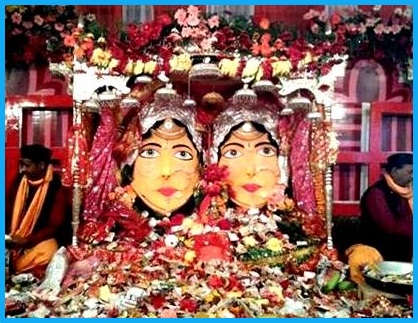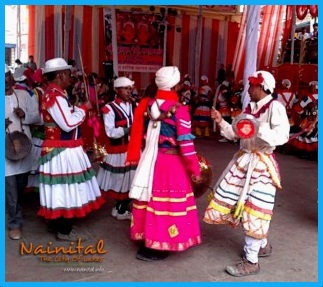The
culture of the present Kumaon is a blend of influences
from the indigenous population as well as from the immigrants to
this region. Consequently, the myths, dialects, languages, folk
literature, festivals, fairs and forms of artistic expression are
examples of the creative influences of the different cultural
groups that constitute Kumaon.
Every peak, lake or mountain range is somehow or the other connected with some myth or the name of a God or Goddess, ranging from those associated with the Shaiva, Shakta and Vaishnava traditions, to local Gods like Ham, Saim, Golla, Chhurmal, Kail Bisht, Bholanath, Gangnath, Airy and Chaumu. Temples are dedicated to the nine famous Goddesses, other local Goddesses, Bhairava, Surya:. and Ganesh. The temples at Jageshwar, Bageshwar, Binsar, Thalkedar, Rameshwar, Pancheshwar, Baijnath and Gananath are devoted to Lord Shiva. The temples of Devidhura, Gangolihat, Pumagiri, Almora, Nainital, Kot Ki Mai and Kotgari Devi are associated with the Shakt tradition, while the region of Lohaghat - Champawat (Mount Kandeo) is associated with Kunna Avatar. This region also has two famous Sun temples.
According to Atkinson there were
35 Vaishnava and 250 Shaiva temples in British Kumaon. Eight
Vaishnava and 64 Shaiva temples were dedicated to the Shakti or
female form alone. Although Lord Shiva's influence prevailed
throughout Kumaon, mainly because of its proximity to the region of
Panchkedars and Kailash - Mansarovar, this did not in any way
hamper the influence of the local folk Gods and Goddesses. Although
the tales of Nanda Devi and Naina Devi have now been linked
together, they began as two different stories.


Naina Devi is a name for the Goddess Parvati. According to the Jagars Naina Devi was established in Kumaon by the Katyuri queen Jiya Rani. On the other hand there is a myth which talks of Sati's committing suicide by jumping into a sacrificial fire, when she and Lord Shiva were insulted by her father Dakshaprajapati during a Yajnya, to which Shiva and Sati had not been invited in the first place. The myth goes on to say that while Shiva was taking Sati's body away, her eye fell down at a spot near the temple of Pashan Devi in Nainital. Therefore, according to myth Naina Devi is none other than the goddess Parvati. (It is the story that Sati was reborn as Parvati).
Nanda Devi is the Greek
Goddess 'Naina', who came to the Himalaya with the
Indo - Greeks and Kushan Kings. However, the fact remains that
Nanda Devi is typically a Kumaoni goddess and most popular in the
region. Referring to the rich religious myths and lores associated
with Uttaranchal, E.T. Atkinson has said: 'To the beliefs of the
great majority of Hindus, the Kumaon (Himalaya) is what Palestine
is to the Christian.'
Kumaoni’s are
fond of music, folk dance, and songs accompanied by local musical
instruments like murli, bina, and hurka. The hurka is played by the
“jurkiya” and the dancer accompanying him, known as “hurkiyari,” is
usually his wife or daughter.They go from place to place narrating
folklores, singing the praise of their gods and goddesses. During
fairs and festivals and at harvest time, they often dance the
Jharva, Chandhur Chhapalior, and many other forms of folk dances.
The popular folk songs are Malushahi, Bair, and Hurkiya Bol.
Marriages in Kumaon are simple. There is no
ostentatious display of wealth, unlike the plains. There is no
dowry taken or given. Sambandh or the other party’s social standing
and family background are very important. This is not linked to
their wealth or other such issue.Marriage is the most important day
in any person’s life, irrespective or his religious denomination.In
India marriages ceremony are of various types for example Brahma or
Dev-Vivah, Gandharv-Vivah, Asur-Vivah and so on. In Kumaon
Dev-Vivah or Brahma-Vivah is prevalent. In this form of ceremony
the parents and the priest play the central role.
